| |
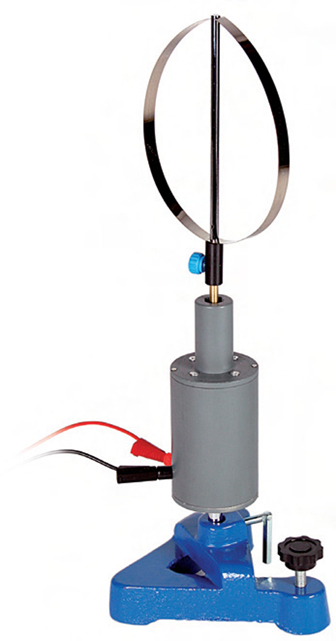 Click to Enlarge
Click to Enlarge
|
Centrifugal Force Apparatus (0765)
Specifications : Size: 16 x 16 x 45 cm – Weight: approx. 2.5 kg – Mounted on base. An experimental insight into centrifugal forces and the flattening of the
“Earth’s poles”. COMPONENTS : • Motor for Centrifugal Force Apparatus • Stackable plug lead, length 50 cm, red • Stackable plug lead, length 50 cm, black • Bench Clamp (2x) • Rolling wire suspension • Centrifugal force rotator • “Earth’s poles flattering” demonstrator • Support Rod, rounded ends, length 500mm (2x) • Support Rod, rounded ends, length 350mm • Metal Bosshead with knobs (3x) • Reel of nylon filament. LAWS & PRINCIPLES INVESTIGATED : • Centrifugal and centripetal force • Model of Earth’s pole flattering.
See Enlarge
|
|
|
|
 Click to Enlarge
Click to Enlarge
|
Torsion Balance (0766)
Static and dynamical measurement of the torsional modulus of a metal wire. Specifications : Size: 37 x 35 x 100 cm – Weight: approx. 2.5 kg. Static and ynamical measurement of the torsional modulus of a metal wire. COMPONENTS : • Torsion balance (with protractor and clamp) • Pan for weights • Reference index • Mass (10 g) (8x) • Balance Arm with nylon string and weights • Metal wire diam. 0,4 mm (length 40 cm) • Metal wire diam. 0,6 mm (length 40 cm) • Metal wire diam. 0,8 mm (length 40 cm). LAWS & PRINCIPLES INVESTIGATED : • Moment of inertia • Torsional modulus • Oscillation’s period • Moment of a force.
See Enlarge
|
|
|
|
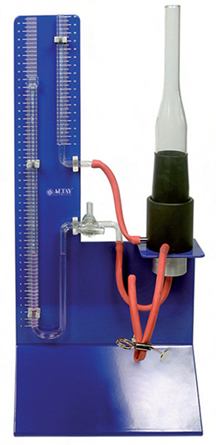 Click to Enlarge
Click to Enlarge
|
Pellat Apparatus (0767)
Specifications : Size: 24 x 28 x 55 cm – Weight: approx. 4.5 kg. The Pellat Apparatus is specifically designed to study the independence of hydrostatic pressure from the shape of the vessel. The apparatus is provided with glass cones of different shapes in order to study this principle. A specifically designed pump system allows us to compare the pressures of different shapes. The apparatus is composed of a supporting panel on which a cylindrical support is used to hold the various shaped containers. COMPONENTS : • Hoffman clip • Support for Vesseles Spare • Membrane Set
• Glassworks Set • Tubes Set • Carrier Structure • U-Tube Manometer. LAWS & PRINCIPLES INVESTIGATED : • Hydrostatic pressure • Communicating vessels principle.
See Enlarge
|
|
|
|
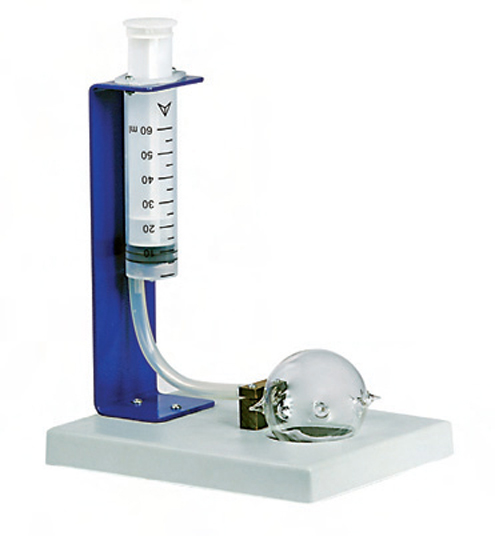 Click to Enlarge
Click to Enlarge
|
Pascal’s Apparatus (0768)
Pascal’s Apparatus has been designed to easily demonstrate that the pressure in a vessel is the same in every direction. The apparatus is mounted in a strong shock resistant plastic base. Specifications : Size: approx 150 x 200 x 250 mm.
See Enlarge
|
|
|
|
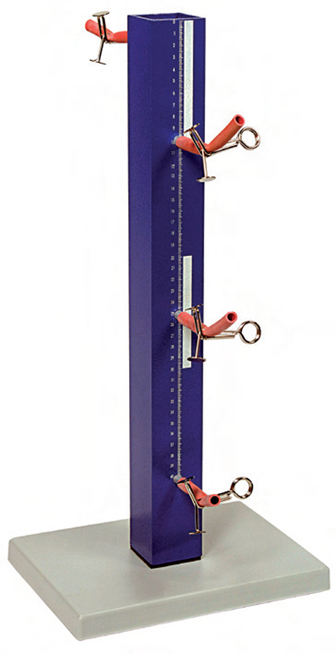 Click to Enlarge
Click to Enlarge
|
Spouting Jar (0769)
The Spouting Jar Apparatus gives a very nice classroom demonstration of
the laws governing pressure in fluids. The apparatus consists of a metal
column filled with water with spout out water at different height along the
vertical column through rubber tubes fixed along its length. The experiment will clearly see the direct relationship between the pressure of the liquid and length of the ejected water column through each spout. Specifications : Size: 25 x 28 x 52 cm – Weight: approx. 1.8 kg,. COMPONENTS : • Spouting Jar Stand • Tube (4x) • Mohr Clip. LAWS & PRINCIPLES INVESTIGATED : • Stevino’s Law.
See Enlarge
|
|
|
|
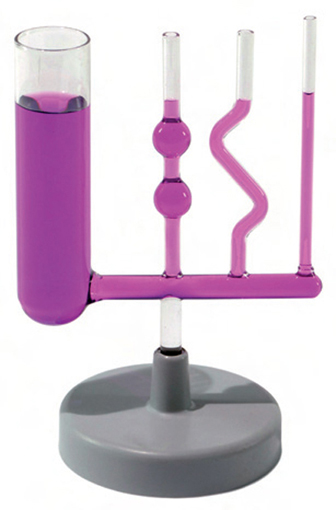 Click to Enlarge
Click to Enlarge
|
Communicating Vessels (0770)
An interesting experiment with connecting vessels. The apparatus is an ideal experiment platform to study the principles of connecting fluid vessels. It consists of a set of four intercommunicating glass tubes of different diameters and shapes. This is an ideal demonstration tool for the observation of fluid dynamics. COMPONENTS : • Communicating Vessels Glasswork • Base. LAWS & PRINCIPLES INVESTIGATED : • Communicating vessels principle.
See Enlarge
|
|
|
|
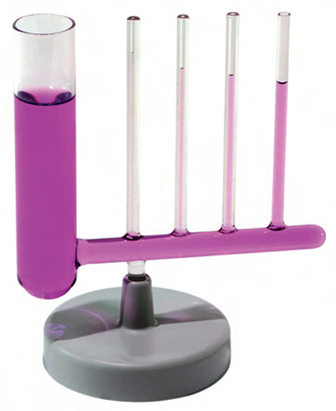 Click to Enlarge
Click to Enlarge
|
Capillary Tubes (0771)
Specifications : Size: 20 x 18 x 20 cm Weight: approx.190 g Mounted on base. COMPONENTS : • Capillary Tubes Glasswork • Base. LAWS & PRINCIPLES INVESTIGATED : • Capillarity • Jurin’s Law.
See Enlarge
|
|
|
|
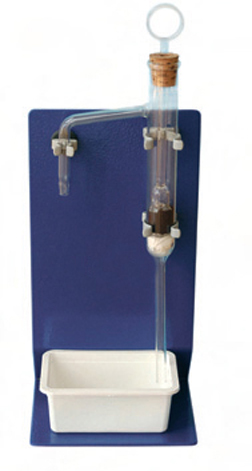 Click to Enlarge
Click to Enlarge
|
Lift Pump on Stand (0772)
Specifications : Size: 14 x 14 x 30 cm – Weight: 1,5 kg – Mounted on base. Discover how pumps work. COMPONENTS : • Lift Pump Glasswork • Base • Basket. LAWS & PRINCIPLES INVESTIGATED : • Pump functioning • Concept of Pressure.
See Enlarge
|
|
|
|
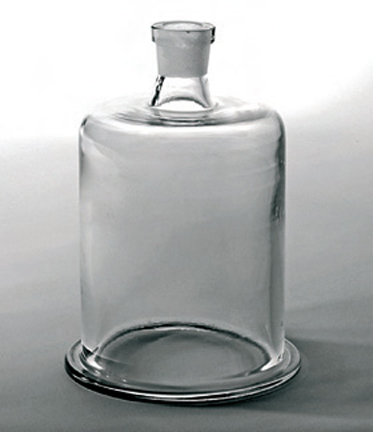 Click to Enlarge
Click to Enlarge
|
Vacuum Bell with Plate (0773)
The classic vacuum bell, for acoustic and mechanics of fluid experiments. Specifications Dimensions: diam. approx 20 cm, height approx 30 cm.
See Enlarge
|
|
|
|
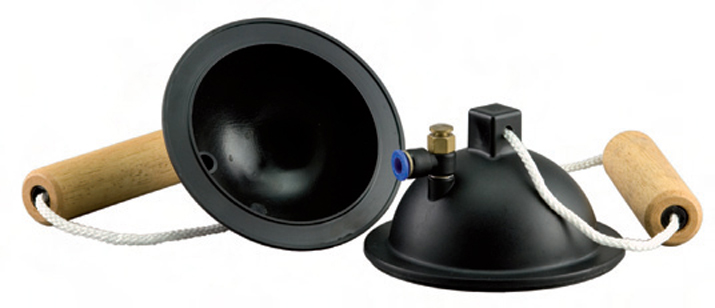 Click to Enlarge
Click to Enlarge
|
Magdeburg Hemispheres (0774)
The clearest and funniest experiment to explain the concept of pressure. Specifications : Dimensions: diam. approx 13 cm. A pair of large PVC hemispheres with mating rims. When the the air is pumped out, the sphere contains a vacuum and could not be pulled apart by hands. LAWS & PRINCIPLES INVESTIGATED : • Concept of pressure • Air pressure.
See Enlarge
|
|
|
|
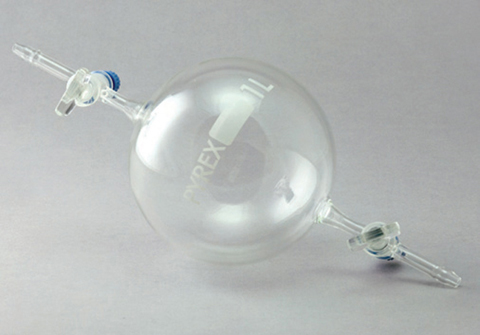 Click to Enlarge
Click to Enlarge
|
Sphere with Two Stopcocks (0775)
Specifications: capacity 1 l. A simple experiment to measure air density. This item consists of a Pyrex glass sphere with two stopcocks. The blown glass can hold low-vacuum and has a capacity of roughly 1 litre. The sphere is equipped with two stopcocks and glass connections for rubber tubes. LAWS & PRINCIPLES INVESTIGATED : • Air density • Vacuum.
See Enlarge
|
|
|
|
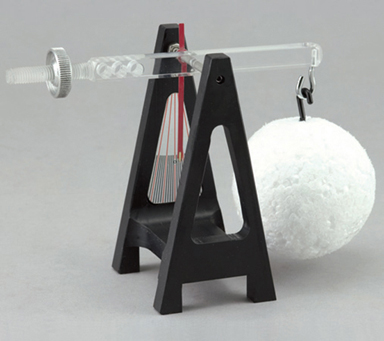 Click to Enlarge
Click to Enlarge
|
Buoyancy Balance (0776)
Dimensions: 17 x 17 x 13 cm. Simple and effective instrument to experience buoyancy of air. This apparatus is constituted of a polystyrene foam ball suspended on a balance arm and mounted on a PVC stand. When located in a vacuum jar and evacuated, the balance inclines as the buoyancy force Diminishes. COMPONENTS : • Balance • Sphere with Hook. LAWS & PRINCIPLES INVESTIGATED : • Buoyancy of air • Air Pressure and level of vacuum.
See Enlarge
|
|
|
|
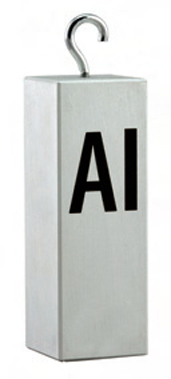 Click to Enlarge
Click to Enlarge
|
Aluminium Cuboid for Buoyancy (0777)
Dimensions: approx. 15 x 3 x 3 cm. Aluminium parallelogram ideal for the study of the hydrostatic pressure. LAWS & PRINCIPLES INVETIGATED : • Hydrostatic pressure • Buoyancy • Weight force.
See Enlarge
|
|
|
|
 Click to Enlarge
Click to Enlarge
|
Boyle’s Law Apparatus (0778)
Size: 20 x 14 x 125 cm – Weight: approx. 4 kg. COMPONENTS : • Graduated Burette • Reservoir tube • Hookup for pipe (4x) • Knob (Policarbonate, Yellow) M5 x 10mm (2x) • Tube for Boyle apparatus • Sliding support for profile (2x) • Stand for Boyle’s law apparatus. LAWS & PRINCIPLES INVESTIGATED : • Boyle’s Law • Atmospheric pressure.
See Enlarge
|
|
|
|
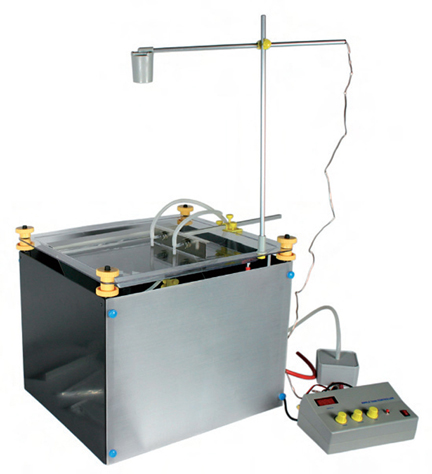 Click to Enlarge
Click to Enlarge
|
Ripple Tank (0779)
Specifications : Size: 52 x 44 x 40 cm – Weight: approx. 6.5 kg. The Ripple Tank is a very effective tool that helps students to understand wave echanics. The Ripple Tank is also used to introduce, develop and visually demonstrate wave theory such as refraction, diffraction and Interference.
Our unique system uses a pulsed air supply so that standing waves are easy to reproduce. The Ripple Tank is supplied with all accessories, including connecting cables and instruction manual. We use a unique pulsed air system to produce accurate and epeatable waves with our Ripple Tank. The electronic controller allows you to control the frequency of the pulses and hence the value of the wavelength. The controller also coordinates the same pulsed air frequency to the stroboscope so that the waves appear to be static and therefore easily measurable. The system also includes a bright light source which is easily moveable to the side of the Ripple Tank.The Ripple Tank is also used to introduce, develop and visually demonstrate wave theory such as refraction, diffraction and interference. Our unique system uses a pulsed air supply so that standing waves are easy to reproduce. The Ripple Tank is supplied with all accessories, including connecting cables and instruction manual. COMPONENTS : • Tank • Ripple Tank Controller • Woofer • Strobe lamp for ripple tank • Tubing Set • Figures Set • Mohr spring • Bush with Brass Insert (8x) • Panels Set • Profiles Set • Beater Set. LAWS & PRINCIPLES INVESTIGATED : • Diffraction of plane waves through a slit • Dispersion • Gravity waves • Interference of waves • Liquid depth and waves propagation speed • Periodic waves • Pulses diffraction • Reflection of plane and circular waves on a curved obstacle • Reflection of plane waves by angle shaped obstacle • Reflection of plane waves on a flat obstacle • Refraction of plane waves • Refraction of plane waves through a plate with parallel faces • Refraction of plane waves through lenses • Stationary waves • Superimposed pulses • Total refraction.
See Enlarge
|
|
|
|







